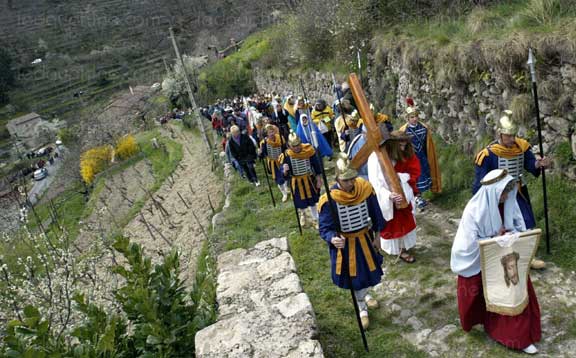
Calvary of Burzet (1) | Rallies and church (2)

Our village is situated at the foot of the Ardeche plateau where the source of the Loire begins at the Mont Gerbier de Joncs (Mount bunch of reeds )
At 25 kilometers north of Aubenas, our chief town, although stricken by rural exodus, has retained its valuable elements and dauntless courage.

The way to the calvary starts at the parish church, It is rough paved, and here we call this ‘calade’. It leads first from the church road, then to the old Puy way, today the walkers way, until the 5th station, before turning left to begin the walk up the calvary mountain. There, the ‘calade’ passes between the chestnut trees, crosses the hamlet of Belvezet where there is a chapel dedicated to “Notre Dame des sept douleurs” ; ( Our Lady of seven sufferings). The climb continues until three crosses at the top.. This walk of about 2 kilometers rises from 540m to 840m altitude. The path continues after the calvary and descends until the chapel of the hamlet of Belvezet. There it rejoins the itinerary taken on the way up.
Along the way of the Cross can be found 24 stations, or little oratories, built with the local stone : granit, 8 stations on the return journey. In all 32 stations covered with round tiles are along the way, and at the top, the three majestic calvay crosses. All is admirably integrated, into the site. On the way beautiful views can be seen in every season : our valleys, the small market town, the terraces built to retain the earth and to render cultivation possible, all bear witness to years of work.
The altitude of the calvary corresponds to the level of the very ancient chestnut tree, after that beeches grow on the mountains and a few plantations of fir trees on the land that is no longer cultivated. In a document dated 5th January 1760, the priest Alix Benoit noted that the calvary was ‘much visited’ at the same place as it is now. This route was decided on as an act of faith, and the fact that it remains, shows that the choice was a good one.
It is here, that each year the procession of the way of the Cross with the participants in costumes, takes place on Good Friday ( Friday after Easter) with 60 people dressed as in the times of Jesus, and where several thousand join them in the procession.
It was in the 12th century towards 1177, that a young shepherd, Benezet CHAUTARD was called by God to have a bridge built in Avignon.
The hamlet of Villard three kilometers from Burzet continues the memory of Saint BENEZET
He has always been revered in Burzet and in Avignon.
A path way leads from Burzet to the hamlet of Villard.
On the site of the clock built towards 1900 and the statue of Our Lady of All Grace, installed towards 1880, can be found the vestiges of an ancien feodal castle, ( some walls, battlements, part of a tower). At the foot of these vestiges, the street of the castle area are paved ; here we call this ‘calade’. Actually these are little streets, roughly paved, that have a certain charm , much more so than the surrounding houses the restoration of which leaves greatly to be desired.
Some say that the feodal castle was destroyed during the wars of religion, others that it was abandoned towards 1739, the owners preferring to live in Paris.
The history of the lords of Burzet is known with precision after 1295 through lord Imbert.
These are today pleasant places for walking.

The village of Burzet is crossed by the river ‘la Bourges’
The names of Burzet and of Bourges are intimately linked as they have the same grammatical root. The Bourges begins high up on the plateau, and underneath Lachamp-Raphael. Above the cascade of ‘Ray Pic’. On its way it has made its bed amongst the rocks of basalt.
During the centuries, farmers have used the river to irrigate the fields and the earth by a system of small canals called here ‘bealiere’.
Since the 15th century, the corn mills use the water force, then in the 18th century, the milling industry used the force of the Bourges river to turn its machines. These factories also called’ manufactures’ worked with silk, the cocoons were already there owing to the mulberry trees that producing synthetic fibres. At the end of the 19th century, about three hundred workers, often women worked in the mills. Little by little, these factories have disappeared. Now there are none left. The buildings have been used for tourism, one is now the departmental center of instruction for firemen.
The waterfalls are now used for producing electricity by the EDF, (Electricity of France) through the installation of central micros.
Sometimes the river gets angry and then it rises and floods like in 1857-1890-1900.
The 4th of October 1935 when the Coulet mill was destroyed by the floods and again nearer to our time, on the 22nd of September 1992.
The trout, main fish of the Bourges, is very popular with many fishing enthusiasts and swimming is very pleasant at ‘Verdier’ and in the numerous peaceful spots .